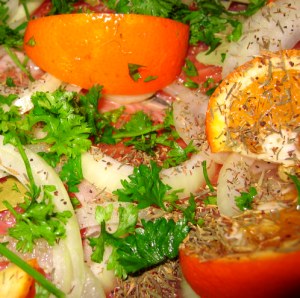A ton of chicken salad was recalled for destruction by the US Department of Agriculture at the beginning of August, because batches were found to be contaminated with the potentially fatal microbe Listeria monocytogenes. The latest development in food science could keep such ready meals on the menu by blocking and killing the bacterium before it can contaminate the food.
Cling film (clingwrap) made from protein rather than plastic could help make outdoor parties and buffet lunches a much safer mealtime. A thin layer of this engineered protein protects those marinated chicken wings and other ready-to-eat meats by stopping those tummy bug microbes in their tracks, according to US researchers.
Food scientists Marlene Janes of Louisiana State University and Mike Johnson of the University of Arkansas have designed and synthesised an entirely edible film from two protein-based substances, which they say can prevent the food poisoning microbe Listeria monocytogenes on ready-to-eat chicken. The team has tested the protein film and reckon they can keep bacterial counts below detectable levels for almost a month.
 “Food production occurs in several stages, each of which provides potential opportunities for bacterial contamination,” explains Johnson. He points out that generally chickens grown for commercial food production live in crowded conditions that are ideal for the spread of bacteria. While thorough cooking will kill most pathogenic bacteria that worm their way around food industry safety measures pre-cooked foods can easily be contaminated between cooking and final packaging steps.
“Food production occurs in several stages, each of which provides potential opportunities for bacterial contamination,” explains Johnson. He points out that generally chickens grown for commercial food production live in crowded conditions that are ideal for the spread of bacteria. While thorough cooking will kill most pathogenic bacteria that worm their way around food industry safety measures pre-cooked foods can easily be contaminated between cooking and final packaging steps.
Stick that ready-to-eat meal in the fridge and leave well alone and you provide a breeding ground for listeria, which can then cross-contaminate other foods in the chiller, such as deli meats and hot dogs. The perfect recipe for a disastrous barbecue, in other words. Listeria poses a particular risk to children, the elderly, and pregnant women, and can cause serious illness and even be life threatening.
Johnson and Janes (now at Louisiana State University) have explored the protective ability of a protein substance called zein, blended with nisin, a natural preservative protein that kills bacteria. They tested the effects of the protein film on chicken breasts from their local supermarket. First, they trimmed off the skin and cut them into five-gram pieces. They froze the pieces and then blasted them with radiation to eliminate any spoilage bacteria found on the chicken.
They then cooked the chicken pieces (without sauce or condiment) and cooled them. They then marinated the cooked chicken in a listeria brew and coated it with the zein-nisin film and put into sterile sample bags in the fridge.
Usually chilling food in the fridge will be enough to prevent bacteria from multiplying too rapidly. But, that is not the case with listeria, which positively thrives in the cold. Leave that cooked chicken at room temperature or uncovered in the fridge overnight and it could be seriously contaminated by the time you’re lighting the barbecue the next day. Just one mouthful could make someone ill.
The Arkansas team carried out a bacterial headcount on their chicken pieces after 4, 8, 16 and 24 days. They found that even after 24 days in the fridge the treated chunks of chicken were free from live listeria. The blended protein film, which Johnson says is perfectly harmless to humans, kills listeria stone dead.
 For Johnson and other food scientists, food safety is a matter of minimizing risks as much as possible, risks that will never completely go away. Pathogenic bacteria, he says, are tiny but formidable adversaries. There were some 65,209 food-poisoning cases in the UK not picked up while abroad in 2000. The Food Standards Agency wants to take Salmonella, E. coli O157, and Listeria monocytogenes off the menu wherever possible. Johnson told us that, “The zein-nisin coating will only work when cold refrigeration temperatures of 4 Celsius are used and only low numbers of the pathogen Listeria monocytogenes are encountered, say about 1,000 per gram. This strategy will not work for temperature-abused foods left out at room temperature.” Now, where’s that tarragon and lemon dressing?
For Johnson and other food scientists, food safety is a matter of minimizing risks as much as possible, risks that will never completely go away. Pathogenic bacteria, he says, are tiny but formidable adversaries. There were some 65,209 food-poisoning cases in the UK not picked up while abroad in 2000. The Food Standards Agency wants to take Salmonella, E. coli O157, and Listeria monocytogenes off the menu wherever possible. Johnson told us that, “The zein-nisin coating will only work when cold refrigeration temperatures of 4 Celsius are used and only low numbers of the pathogen Listeria monocytogenes are encountered, say about 1,000 per gram. This strategy will not work for temperature-abused foods left out at room temperature.” Now, where’s that tarragon and lemon dressing?
SOURCE: Journal of Food Science.
 Education regarding lifestyle, diet and exercise might be the key to avoiding chronic inflammation. “A comprehensive food-based strategy for reducing inflammation and thus reducing the incidence and severity of a large array of chronic illnesses and declining health is supported by a large and growing volume of scientific investigations,” US researchers suggest.
Education regarding lifestyle, diet and exercise might be the key to avoiding chronic inflammation. “A comprehensive food-based strategy for reducing inflammation and thus reducing the incidence and severity of a large array of chronic illnesses and declining health is supported by a large and growing volume of scientific investigations,” US researchers suggest. NHS Choices finally published its critique of the Harvard red meat research that had the tabloids screaming that meat kills earlier this week. I provided some commentary on Sciencebase soon after. Anyway, this is what NHS Choices concludes:
NHS Choices finally published its critique of the Harvard red meat research that had the tabloids screaming that meat kills earlier this week. I provided some commentary on Sciencebase soon after. Anyway, this is what NHS Choices concludes:

 “Food production occurs in several stages, each of which provides potential opportunities for bacterial contamination,” explains Johnson. He points out that generally chickens grown for commercial food production live in crowded conditions that are ideal for the spread of bacteria. While thorough cooking will kill most pathogenic bacteria that worm their way around food industry safety measures pre-cooked foods can easily be contaminated between cooking and final packaging steps.
“Food production occurs in several stages, each of which provides potential opportunities for bacterial contamination,” explains Johnson. He points out that generally chickens grown for commercial food production live in crowded conditions that are ideal for the spread of bacteria. While thorough cooking will kill most pathogenic bacteria that worm their way around food industry safety measures pre-cooked foods can easily be contaminated between cooking and final packaging steps. For Johnson and other food scientists, food safety is a matter of minimizing risks as much as possible, risks that will never completely go away. Pathogenic bacteria, he says, are tiny but formidable adversaries. There were some 65,209 food-poisoning cases in the UK not picked up while abroad in 2000. The Food Standards Agency wants to take Salmonella, E. coli O157, and Listeria monocytogenes off the menu wherever possible. Johnson told us that, “The zein-nisin coating will only work when cold refrigeration temperatures of 4 Celsius are used and only low numbers of the pathogen Listeria monocytogenes are encountered, say about 1,000 per gram. This strategy will not work for temperature-abused foods left out at room temperature.” Now, where’s that tarragon and lemon dressing?
For Johnson and other food scientists, food safety is a matter of minimizing risks as much as possible, risks that will never completely go away. Pathogenic bacteria, he says, are tiny but formidable adversaries. There were some 65,209 food-poisoning cases in the UK not picked up while abroad in 2000. The Food Standards Agency wants to take Salmonella, E. coli O157, and Listeria monocytogenes off the menu wherever possible. Johnson told us that, “The zein-nisin coating will only work when cold refrigeration temperatures of 4 Celsius are used and only low numbers of the pathogen Listeria monocytogenes are encountered, say about 1,000 per gram. This strategy will not work for temperature-abused foods left out at room temperature.” Now, where’s that tarragon and lemon dressing?